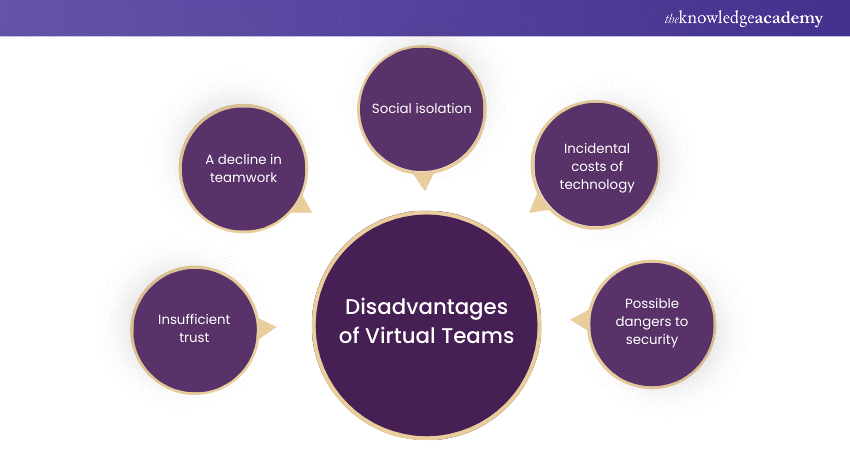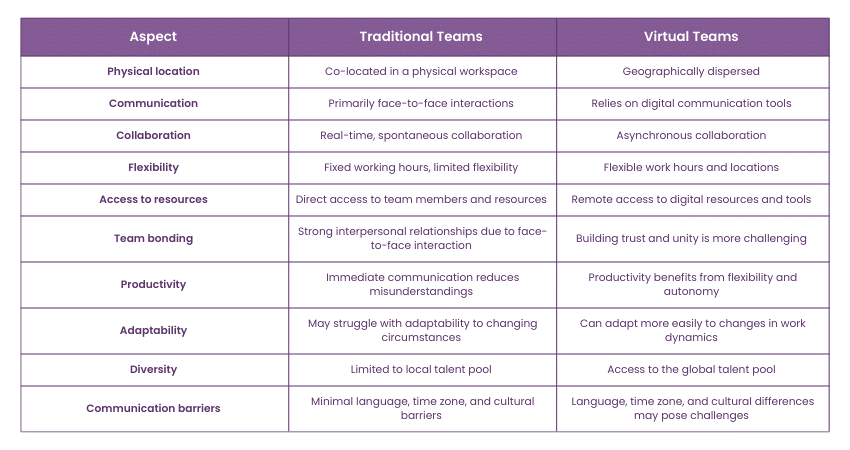We may not have the course you’re looking for. If you enquire or give us a call on + 800 908601 and speak to our training experts, we may still be able to help with your training requirements.
Training Outcomes Within Your Budget!
We ensure quality, budget-alignment, and timely delivery by our expert instructors.

Are you curious about modern workplace dynamics? If so, you might be interested in learning about Virtual Teams. So, "What are the Advantages and Disadvantages of Virtual Teams?” you may ask. In this comprehensive blog, we'll delve into the concept of Virtual Teams, uncovering their benefits and drawbacks. Let's explore how Virtual Teams shape our work in today's interconnected world.
Explore our blog to discover the Advantages and Disadvantages of Virtual Teams. Additionally, learn how to navigate these challenges for effective Virtual Teamwork.
Table of Contents
1) What are Virtual Teams?
2) Virtual Team Advantages and Disadvantages
3) Advantages of Virtual Teams
4) Disadvantages of Virtual Teams
5) Difference between Traditional Teams and Virtual Teams
6) Conclusion
What are Virtual Teams?
Virtual Teams are modern workgroups comprising individuals collaborating on projects or tasks from diverse geographical locations. Unlike traditional office setups, Virtual Teams interact with digital communication mediums like email, video conferencing, and collaboration platforms. This arrangement allows team members to contribute regardless of physical proximity, enabling companies to tap into a global talent pool.
Virtual Teams offer flexibility in work, allowing employees to work remotely, manage personal commitments, and maintain a better work-life balance. Despite the absence of face-to-face interactions, Virtual Teams leverage technology to foster collaboration, share information, and coordinate efforts efficiently. Virtual Teams signify a fundamental change in organisations' workforce structure, prioritising connectivity and digital tools for shared objectives.
Virtual Team Advantages and Disadvantages
Virtual Teams come with their own set of Advantages and Disadvantages. Understanding these can help organisations maximise the benefits while mitigating potential challenges.
Advantages of Virtual Teams
Virtual Teams optimise resources and enhance productivity in today's evolving work landscape. Let's explore their numerous benefits:
1) Financial savings
A notable benefit of Virtual Teams lies in the opportunity for significant cost reduction. Companies can cut costs on rent, utilities, and office supplies by eliminating the need for physical office space. Virtual teams also reduce commuting, saving transportation expenses for both employees and employers.
2) Enhanced efficiency
Virtual teams often enjoy flexible work schedules, enabling members to work during their most productive hours. This flexibility enhances efficiency, as individuals can align their workday with peak performance times.
Moreover, virtual collaboration tools enable real-time communication and document sharing, streamlining workflow processes and reducing bottlenecks.
3) No pointless gatherings
Traditional office environments often involve numerous meetings that may only sometimes be productive. Virtual Teams, on the other hand, tend to have fewer unnecessary gatherings since communication is primarily digital. This enables team members to concentrate on tasks, enhancing productivity by eliminating interruptions.
4) A good work-life equilibrium
Virtual Teams provide enhanced flexibility for balancing work and personal life. Working remotely allows team members to better handle childcare or appointments, potentially boosting job satisfaction and overall well-being.
5) Higher rates of employee retention
The independence and adaptability of virtual teams can help to improve employee retention. Employees who can work from any place are more likely to stay with the organisation in the future. Also, Virtual Teams may attract people who prefer remote work plans, hence increasing retention rates.
6) The greater reservoir of talent
Virtual Teams can access a global talent pool, allowing organisations to recruit individuals with specialised skills regardless of location. This diversity of talent brings fresh perspectives and expertise to the team, fostering innovation and creativity.
7) Quicker time to market
With Virtual Teams, companies can assemble project teams rapidly, regardless of geographical constraints. This agility enables organisations to respond quickly to market demands and deliver products or services more efficiently. By leveraging virtual collaboration tools, teams can coordinate efforts in real-time, accelerating the time to market.
Elevate your skills with our Virtual Assistant Course today!
Disadvantages of Virtual Teams
Let's explore the Disadvantages of Virtual Teams in depth:

1) Insufficient trust
Building and maintaining trust within virtual teams can pose greater challenges compared to traditional office settings. In virtual environments, regular face-to-face interactions foster stronger teamwork and understanding. However, miscommunication, perceived lack of accountability, and misunderstandings can gradually undermine trust, diminishing morale and productivity.
Trust in Virtual Teams hinges on transparent communication, consistent commitment fulfilment, and a shared purpose. Effective leadership involves setting clear expectations, providing regular feedback, and organising informal team-building activities to strengthen cohesion and trust among members.
2) A decline in teamwork
Effective collaboration is crucial for attaining common objectives and achieving favourable results. However, Virtual Teams may need help fostering cooperation and synergy among team members. Without the spontaneous interactions in physical workspaces, individuals may feel disconnected from colleagues, impacting their participation in team activities.
Organisations must prioritise building a collaborative culture within Virtual Teams to address the decline in teamwork. This includes leveraging digital collaboration tools to facilitate brainstorming sessions, project discussions, and collective decision-making.
Leaders should promote open communication and knowledge sharing and reward collaborative efforts to reinforce teamwork in the virtual environment.
3) Social isolation
A significant obstacle associated with remote work is the risk of team members experiencing social isolation. Remote work may cause loneliness and disconnection, especially for those valuing social interaction and belonging in interpersonal settings. Team members may need the informal social interactions found in office environments to build meaningful connections with their colleagues.
Addressing social isolation requires proactive efforts from both individuals and organisations. Encouraging regular Virtual Team meetings and informal social gatherings can help recreate the sense of community in traditional workplaces.
Additionally, organisations can offer virtual wellness programs, employee resource groups, and online social events to support the well-being of remote team members.
4) Incidental costs of technology
While technology enables virtual collaboration and communication, it also comes with incidental costs that organisations must consider. Investing in reliable internet connections, video conferencing software, project management tools, and cybersecurity measures can quickly add up, especially for organisations operating on tight budgets.
Moreover, remote maintenance and troubleshooting of technology issues can demand significant time and resources from IT teams. Organisations should weigh the advantages and disadvantages of utilising technology for Virtual Teams prior to making decisions.
Regular tech assessments, bulk vendor discounts, and team training mitigate incidental tech costs effectively. Furthermore, prioritising investments in user-friendly, scalable, and secure technology solutions can enhance the efficiency and effectiveness of Virtual Team collaboration.
5) Possible dangers to security
Remote work introduces unique cybersecurity risks that organisations must address to protect sensitive data and intellectual property. Virtual Teams lack robust security, making them susceptible to cyber threats like phishing, malware, and unauthorised data access. A single security violation can cause significant problems, like losing money, damaging reputation, and getting into legal trouble.
Safeguarding against security threats requires a multi-layered approach encompassing technology, policies, and employee education. Implementing encryption protocols, firewalls, and access controls can help secure data transmitted over virtual networks.
Additionally, organisations should establish clear security policies and procedures for remote work, including password management and data handling guidelines. Security training empowers employees to recognise and respond to threats, effectively minimising security breaches within Virtual Teams.
Enhance your sales skills with our Virtual Salesperson Training!
Difference between Traditional Teams and Virtual Teams
Understanding Traditional Teams vs Virtual Teams is crucial for optimising collaboration and productivity in modern work dynamics. Let's explore the differences between these two approaches:

1) Traditional Teams:
Traditional Teams are characterised by co-located members who work together in a physical workspace, such as an office or a manufacturing facility. This proximity facilitates spontaneous interactions, face-to-face communication, and real-time collaboration among team members.
Team members often have direct access to each other, enabling quick problem-solving, decision-making, and feedback loops. Moreover, Traditional Teams typically follow a structured work schedule and adhere to the organisation's established norms and protocols.
In a conventional team environment, interpersonal relationships play a significant role in fostering camaraderie, trust, and cohesion among team members. Regular face-to-face interactions facilitate the development of strong bonds and a sense of belonging within the team.
Additionally, Traditional Teams benefit from the immediacy and clarity of in-person communication, which reduces the likelihood of misunderstandings and misinterpretations. Due to physical proximity and fixed working hours constraints, Traditional Teams may need more flexibility. This rigidity can restrict adaptability to changing circumstances and may impede innovation and creativity within the team.
2) Virtual Teams:
In contrast, Virtual Teams consist of geographically dispersed members collaborating remotely using digital communication tools and technology platforms. Virtual Teams transcend traditional boundaries of time and space, allowing members to work from diverse locations and even different organisations.
Virtual Teams predominantly communicate via email, video conferencing, instant messaging, and project management software. Flexible asynchronous communication accommodates varied work styles and schedules, fostering productivity and balancing personal commitments.
Virtual Teams leverage technology to overcome geographical barriers and facilitate seamless collaboration across distances. By embracing remote work arrangements, organisations can access a global talent pool and foster team diversity. Virtual Teams boost productivity and efficiency with autonomy, enabling adequate time and resource management for individuals.
However, Virtual Teams may encounter challenges related to communication barriers, such as differences in language, time zones, and cultural practices. Building trust, support, and team unity is more complex in Virtual Teams because face-to-face interactions are less likely.
Conclusion
Virtual Teams offer numerous Advantages, including financial savings, enhanced efficiency, and access to a global talent pool. However, they also present challenges such as building trust, fostering teamwork, and addressing social isolation. By understanding the Advantages and Disadvantages of Virtual Teams, organisations can maximise their productivity and morale.
Unlock your potential with our Virtual Consultant Training now!
Frequently Asked Questions

Virtual Teams are groups of individuals from different geographic locations who collaborate on projects or tasks. They communicate digitally using email, video conferencing, and collaboration tools. This allows team members to work remotely while still effectively contributing to the team's goals and objectives.

Virtual Teams allow individuals to collaborate on projects or tasks from different locations, leveraging digital communication tools. Virtual Teams facilitate flexibility by enabling remote work arrangements and providing access to a diverse talent pool. Efficient collaboration across geographic boundaries can result in increased productivity and innovation. It's a great way to work together effectively, regardless of location.

The Knowledge Academy takes global learning to new heights, offering over 30,000 online courses across 490+ locations in 220 countries. This expansive reach ensures accessibility and convenience for learners worldwide.
Alongside our diverse Online Course Catalogue, encompassing 17 major categories, we go the extra mile by providing a plethora of free educational Online Resources like News updates, Blogs, videos, webinars, and interview questions. Tailoring learning experiences further, professionals can maximise value with customisable Course Bundles of TKA.

The Knowledge Academy’s Knowledge Pass, a prepaid voucher, adds another layer of flexibility, allowing course bookings over a 12-month period. Join us on a journey where education knows no bounds.

The Knowledge Academy offers various Virtual Online Job Roles Trainings, including Virtual Assistant (VA) Masterclass, Virtual Consultant Training and Virtual Event Planner. These courses cater to different skill levels, providing comprehensive insights into Virtual Teams.
Our Business Skills Blogs cover a range of topics related to Virtual Teams, offering valuable resources, best practices, and industry insights. Whether you are a beginner or looking to advance your Business skills, The Knowledge Academy's diverse courses and informative blogs have you covered.







 Top Rated Course
Top Rated Course




 If you wish to make any changes to your course, please
If you wish to make any changes to your course, please


